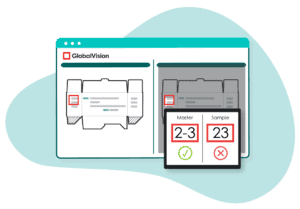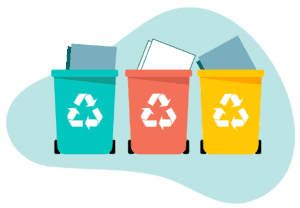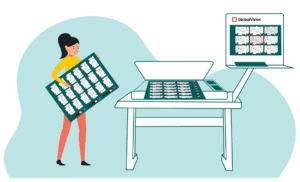How to Avoid Waste on the Print Production Floor
Date: November, 2020 | Category: Quality | Author: Seth Richtsmeier
From a business perspective, it makes sense to avoid waste whenever possible. Print waste in particular costs companies time and money, since any mistakes made during a print run will have to be corrected with additional resources. It’s more than just material waste — there’s also employee labor that must be factored in.
The True Costs of Excess Print Waste in Production
According to studies from Gartner, 50 percent of business waste is composed of paper products, with the average office worker going through 10,000 sheets of paper per year. These numbers alone are staggering and don’t even account for other print products such as boxes and packaging.
There are also other costs associated with printing, including ink, warehousing space, and postage. These additional fees can add up to 30 times the purchasing price of the paper itself – a significant expenditure.
Beyond the financial implications, there’s also the environmental impact of waste. With 40 percent of the world’s timber being cut down for paper production, brands and consumers alike should look for ways to limit excess scrap.
4 Steps to Minimize Print Production Waste
To reduce the amount of print and packaging waste created, there are several steps companies can take. Here are a few key recommendations.
1. Start with Employee Training
 A common factor when it comes to waste is human error. From typos to incorrect colors and fonts to formatting issues, there are many ways things can go wrong. “Mistakes caused by human error can definitely turn into possible reprints and extra platemaking” says John Reinhardt, Marketing Director of Prairie State Group, a leading packaging company in Franklin Park, IL.
A common factor when it comes to waste is human error. From typos to incorrect colors and fonts to formatting issues, there are many ways things can go wrong. “Mistakes caused by human error can definitely turn into possible reprints and extra platemaking” says John Reinhardt, Marketing Director of Prairie State Group, a leading packaging company in Franklin Park, IL.
As soon as a new employee joins the team, they should receive adequate training to ensure they know what’s acceptable, how to spot errors, and how to correct those errors. Training should continue on a regular basis to ensure that everyone is aware of best practices.
2. Review Pre-Press Files with Care
 Before sending projects off to print, run through the files a few times to catch any errors. It’s often best to have more than a single person check for mistakes, as it’s easy for a writer or designer to skip over their own errors.
Before sending projects off to print, run through the files a few times to catch any errors. It’s often best to have more than a single person check for mistakes, as it’s easy for a writer or designer to skip over their own errors.
Catching typos and formatting issues early on saves time, money, and resources. Always have at least two sets of eyes review each file before sending off any major print job. It may help to have a checklist available with things to look out for, including updated logos, correct color swatches, common spelling mistakes, and anything else that may be looked over otherwise.3. Automated Quality Control
 There’s a reason it’s called human error – we’re all human and we all make mistakes. While it’s helpful to have multiple people review a print file, there’s always the chance of a problem slipping through the cracks. With automated quality control, the proofing process is easier, more efficient, and more accurate.
There’s a reason it’s called human error – we’re all human and we all make mistakes. While it’s helpful to have multiple people review a print file, there’s always the chance of a problem slipping through the cracks. With automated quality control, the proofing process is easier, more efficient, and more accurate.
Using digital inspections to compare proof documents against original files, conversion errors, and printing defects can be quickly detected and addressed. Users can review inspection reports and approve files for a full print run once ready. This early detection can prevent large-scale misprints, which saves the company from having to toss out entire batches. Again, this saves print materials, ink, coatings, and other costs associated with print waste. It also reduces the company’s environmental footprint (more on that below).4. Inventory Management
 While printing materials with errors is wasteful, storage issues that can damage products can be just as detrimental. All paper-based products should be stored in cool, dry environments to prevent mildew. It’s also suggested that these products be protected from threats such as fire, water, and contaminants.
While printing materials with errors is wasteful, storage issues that can damage products can be just as detrimental. All paper-based products should be stored in cool, dry environments to prevent mildew. It’s also suggested that these products be protected from threats such as fire, water, and contaminants.
These recommendations should be applied to raw materials as well as finished print products, which can be even more costly to replace due to ink and other coating costs.
 Minimizing Environmental Impact
Minimizing Environmental Impact
In addition to taking control of the waste stream by minimizing mistakes, companies should also consider the environmental implications of their practices. When choosing packaging materials, prioritize recyclable paper products. This may involve choosing different coatings and ink to ensure the package can be recycled with other paper and cardboard materials.
There are also several packaging materials that don’t involve paper at all. Corn- and mushroom-based packaging are gaining traction as eco-friendly options. A seaweed-based material called agar is in the early stages of development as a viable packaging alternative as well. Keep an open mind about new products and consider how they can fit into your packaging stream.
 Avoid Print Waste with Quality Control
Avoid Print Waste with Quality Control
Ultimately, the best way to reduce waste is to invest in your quality control. Eliminating the risk of misprints and formatting issues will save countless reams of paper and other materials. Automated quality control systems are a necessity for waste prevention. As Sales Manager Dave Mickiewicz from General Converting Inc. says “With [automated quality control], sheets can be quickly inspected to check for smashes, hickeys, content errors. It has definitely helped eliminate lost time and wasted materials”.
To learn how your company can benefit from significant returns by automating your quality control process, check out GlobalVision’s guide Shifting Gears from Manual to Automated Quality Control.
_________________________________________________________________________________________
Ensure your content is always error-free in record time with GlobalVision. Try it now for free.
Keep up with the latest updates in automated quality control. Sign up for our newsletter.









